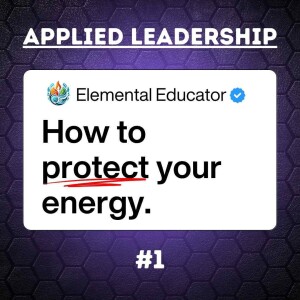
Leadership isn't just about strategy—it’s about energy. In this solo episode, Tyler shares 3 high-impact shifts every leader needs after hearing Phil’s story. In this Applied Leadership episode, Tyler Comeau breaks down 3 transformational takeaways from his interview with Phil Januszewski—and what to do with them: 🧠 Takeaway 1: Energy is Contagious (and Strategic) Backed by research from Armston and Daniel Goleman, energy sets the emotional baseline for teams. Leaders must protect it. 🔁 Action Step: Audit your leadership calendar. Add 15 daily minutes for joy. 💥 Takeaway 2: Stop Leading from Empty Gallup and Maslach's work on burnout shows that when leaders deplete, teams crumble. 🔁 Action Step: Block 1 hour this week—no meetings, no output. Just input. 🌱 Takeaway 3: Positivity Isn't Soft—It's Strategic Fredrickson’s Broaden-and-Build Theory and Google’s Project Aristotle both agree: high-functioning teams thrive on positivity and psychological safety. 🔁 Action Step: Start your next meeting by asking, “What’s one small win we can celebrate this week?” Then pause. Hold space. This episode isn’t just reflection—it’s activation. Because if your story doesn’t shape your leadership… what’s the point? 💼 Ways to Work with Tyler Website – https://www.elementaleducator.com Leadership Coaching, Keynotes, & Courses 🔗 Connect with Tyler Instagram – https://www.instagram.com/elemental_educator YouTube – https://www.youtube.com/@ElementalEducator Email – tyler@elementaleducator.com 💬 Question for You: When was the last time you protected your energy on purpose? Drop your answer below 👇 Affiliate Links Riverside – https://www.riverside.fm/?via=tyler-comeau SavvyCal – https://www.savvycal.com/?via=tyler-comeau Keychron – https://www.keychron.com/?ref=TYLERCOMEAU Toggl – https://www.toggl.com/?via=tyler-comeau Podbean Unlimited Hosting – https://www.podbean.com/elementaleducator Podbean Business Plan – https://www.podbean.com/pro/elementaleducator
References
Arnsten, A. F. T. (2009). Stress signalling pathways that impair prefrontal cortex structure and function. Nature Reviews Neuroscience, 10(6), 410–422. https://doi.org/10.1038/nrn2648
Ashkanasy, N. M., & Dorris, A. D. (2017). Emotions in the workplace. Annual Review of Organizational Psychology and Organizational Behavior, 4, 67–90. https://doi.org/10.1146/annurev-orgpsych-032516-113231
Edmondson, A. C. (1999). Psychological safety and learning behavior in work teams. Administrative Science Quarterly, 44(2), 350–383. https://doi.org/10.2307/2666999
Fredrickson, B. L. (2001). The role of positive emotions in positive psychology: The broaden-and-build theory of positive emotions. American Psychologist, 56(3), 218–226. https://doi.org/10.1037/0003-066X.56.3.218
Gallup. (2020). Employee burnout: Causes and cures. Gallup. https://www.gallup.com/workplace/288539/employee-burnout-part-main-causes.aspx
Goleman, D. (2000). Leadership that gets results. Harvard Business Review, 78(2), 78–90. https://hbr.org/2000/03/leadership-that-gets-results
Krekel, C., Ward, G., & De Neve, J.-E. (2019). Employee wellbeing, productivity, and firm performance. Centre for Economic Performance, London School of Economics and Political Science. https://doi.org/10.2139/ssrn.3356581
Maslach, C., & Leiter, M. P. (2016). Understanding the burnout experience: Recent research and its implications for psychiatry. World Psychiatry, 15(2), 103–111. https://doi.org/10.1002/wps.20311
Project Aristotle. (2015). Guide: Understand team effectiveness. Google Re:Work. https://rework.withgoogle.com/print/guides/5721312655835136/
No comments yet. Be the first to say something!